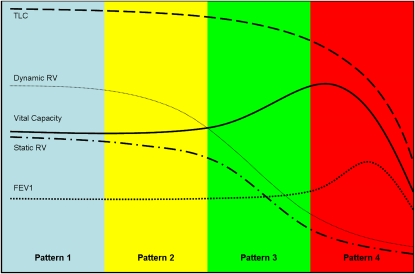Figure 2.
Patterns of response to bronchoscopic lung volume reduction (BLVR) pattern 1: treatment produces no change in lung physiology. Pattern 2: treatment reduces dynamic gas trapping (dynamic RV), which improves exercise capacity. Static volumes and spirometry are unaffected. Pattern 3: treatment reduces static and dynamic gas trapping (static RV and dynamic RV), but has minimal effect on total lung capacity (TLC). FVC increases, but FEV1 does not. Pattern 4: treatment reduces static and dynamic gas trapping (static RV and dynamic RV) and TLC. FVC and FEV1 improve. Beyond a critical threshold, further reductions in TLC have a negative impact on VC and then FEV1, and the benefits of treatment diminish.

